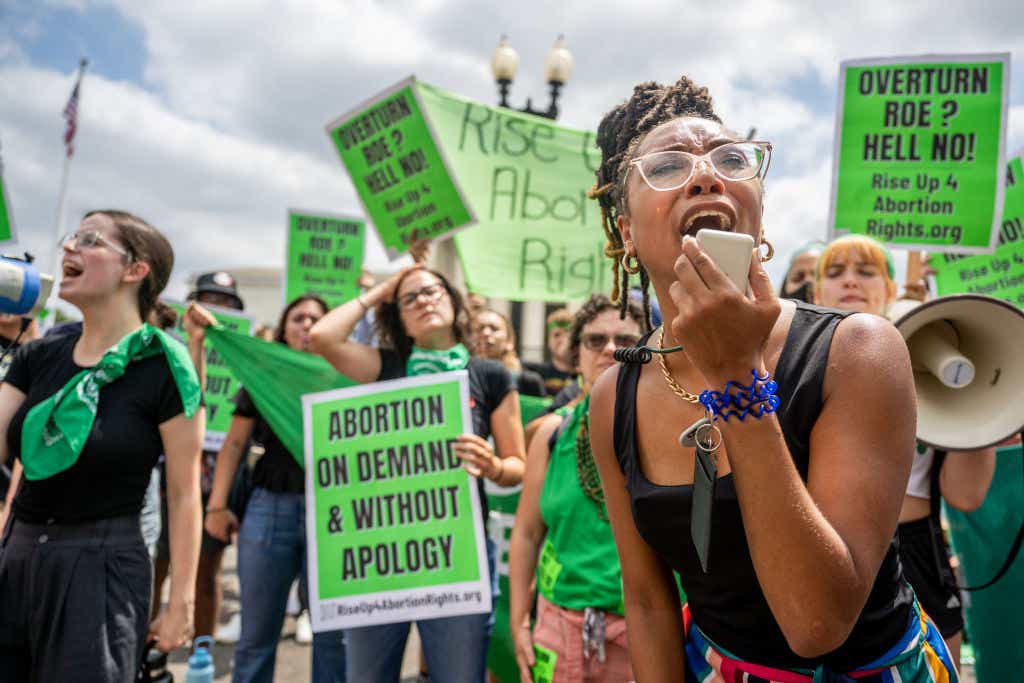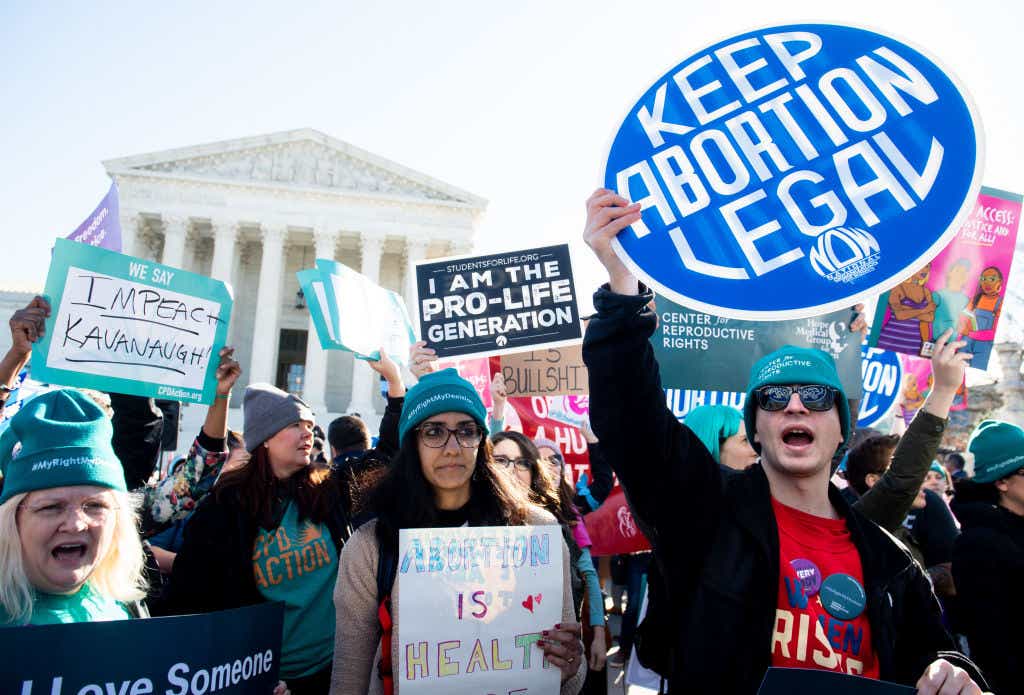It’s been more than a year since the Supreme Court rescinded the five-decade-old right to abortion under Roe v. Wade on June 24, 2022, but the fallout is far from over. GOP presidential contenders sparred over how to handle this topic nationally at Wednesday's debate, but for now, all the action is taking place at the state level.
Earlier this month, Ohio — a state that went for former President Trump in 2020 — rejected a Republican-backed measure that would have made it more difficult to enshrine abortion rights in its constitution.
Then again, the Buckeye State is hardly the first swath of Trump territory to oppose such a measure. Kansas led the way in August 2022, voting down a constitutional amendment that would’ve gotten rid of abortion protections.
“About 30 percent of registered Republicans voted 'no' on the referendum here,” says Alexandra Middlewood, who’s a political science professor at Wichita State University. “So a sizable chunk of Republican voters who support abortion rights to some extent are making their opinion heard, and we’re seeing this in these other states as well.”
Here’s a look at why the failed Ohio amendment matters — and how it’s part of a larger pattern.
What happened with Ohio’s abortion vote, and why does it matter?
During a special Ohio election on Aug. 9, Republicans put a question on the ballot, known as Issue 1, which asked whether voters should be able to change the state constitution with a simple majority vote (that’s 51 percent or more), or if such a move should require a higher, 60 percent majority threshold. (It would have also required petitioners to get signatures from all 88 Ohio counties to get a constitutional amendment on the ballot.) Voters responded with a resounding no.
Though the measure didn’t specifically mention abortion rights, conservative lawmakers in the state plainly stated their goal: They hoped to create a more difficult path for an abortion proposal that’s on the ballot this November and already has a surprising amount of public backing. The constitutional amendment would support the “right to make and carry out one's own reproductive decisions,” and a USA TODAY Network/Suffolk University poll (conducted before the vote on Issue 1), found that about 58 percent of Ohio voters are in favor.
Political analyst Larry Gerston says the state is a prime example of how abortion is weakening the GOP’s position in the nation's largest metro areas. “Republican candidates aren’t reading the tea leaves very well,” Gerston tells us. “They’re reacting to activists and missing the fact that so many other people within the party may be feeling differently on the issue.”
Despite this setback, conservative activists remain optimistic. Michael Gonidakis, who’s president of the anti-abortion group Right to Life, predicts that roughly 20 percent of those who voted "no" on Issue 1 were pro-life Republicans, but he expects them to "come home for November."
"We often say here in Ohio: It's God, guns, and babies," Gonidakis tells us. "You need the support of the pro-life community, the Second Amendment community, and the faith-based community to win a primary in Ohio, statewide or locally, and that's never going to change."
What’s happening to abortion rights in other parts of the country?
The U.S. Supreme Court’s overturning of Roe v. Wade has shifted the legal battle over abortion to the states — and so far, more than a dozen of them have enacted extremely restrictive abortion bans, with the majority making no exceptions for even rape or incest.
This, in turn, has left more than 25 million women between the ages of ages 15 to 44 living in states where the law makes abortions hard, if not impossible, to obtain. But this crackdown isn’t necessarily a reflection of public opinion as a whole, revealing a fascinating political disconnect.
A majority of Americans already supported some abortion rights even before the reversal of Roe, and this sentiment hasn’t exactly gone away. According to the most recent Gallup poll in July, most Americans agree that the procedure should be legal to a certain extent: 34 percent believe abortion should be legal "under any circumstances," 51 percent say it should be legal “only under certain circumstances,” and another 13 percent say it should be illegal in all circumstances.

Given this broad support for at least some access to abortion, it’s no surprise that Ohio is part of a growing pattern. Six states have had abortion measures on the ballot — three of the proposals were in favor of abortion (California, Michigan, and Vermont) and three tried to limit the procedure (Kansas, Kentucky, and Montana). In each case, protecting reproductive rights won out, and this was true even in traditionally conservative parts of the country.
“There is this sense among even Republican voters that the party’s gone too far,” says Rosenberg. “The party’s either going to have to change their position on abortion as a national party, or they're going to have to suffer a very severe political price — potentially for many years to come.”
How are women responding to the end of Roe?
Women started registering to vote in droves immediately after the fall of Roe v. Wade — and this has been especially true in conservative states.
The first signs of a shift came from Kansas, where voter registrations among women surged by double digits between the Dobbs decision and the 2022 referendum on abortion rights, according to data compiled by Democratic firm TargetSmart. Similar shifts were also seen in both Michigan and Ohio, where women registering to vote outpaced the number of men by double-digit percentages.
Key battleground states even saw a surge. In Pennsylvania, women accounted for more than 56 percent of newly registered voters since the June 2022 decision, with nearly two-thirds registering as Democrats — and more than half of those were under the age of 25.

At the same time, these upticks aren’t entirely surprising. This has been happening for decades: "Women have registered and voted at higher rates than men in every presidential election since 1980," according to historical data compiled by CAWP.
Still, experts agree that these conservative-leaning states will continue to see this enthusiasm as part of a larger fight against Republican extremism. “There has been a huge rebellion against MAGA in the United States, and a huge part of this is being driven by women,” says Democratic strategist Simon Rosenberg.
What’s next for abortion rights?
After the Ohio vote, major abortion rights groups are looking for similar wins in other Republican-led states as part of a nationwide effort. This namely includes Arizona and Florida.
In early August, the political action committee Arizona for Abortion Access filed proposed language for a constitutional amendment with the secretary of state’s office that would restore the right to an abortion up until fetal viability, which is typically around 22 to 24 weeks of pregnancy. (As it currently stands, the state outlaws the procedure after 15 weeks).
In order to get it on the ballot for November’s election, organizers need at least 383,923 valid signatures from voters by July 3, 2024, and they believe it’s entirely possible.
“Our mission is to counteract restrictive bans and ensure that every person in Arizona has the right to access safe and legal abortion care. In the face of ongoing challenges, we believe that public support is on our side,” the group states.
Reproductive rights activists also see Florida as a potential foothold. The state currently bans most abortions after 15 weeks, though it’s widely expected to be reduced to 6 weeks following a state’s Supreme Court decision in the fall.
Abortion rights groups are wasting no time, though. Floridians Protecting Freedom is leading a statewide effort to pass a constitutional amendment to protect access to abortion. So far, organizers say they’ve collected 650,000 petitions — which is more than half of what they’re aiming for to get the proposed measure on Florida’s ballot in November.
Anna Hochkammer, who’s executive director of Florida Women’s Freedom Coalition, says she has been blown away by the strong grassroots support. She estimates that more than 200 organizations ranging from local labor unions to book clubs and religious groups have been actively collecting volunteer petitions.
“Floridians think it's completely inappropriate for the government to make decisions for doctors and their patients,” she tells us. “These are complicated decisions, and they want people to be able to make those choices for themselves, regardless of how they feel about abortion.”









